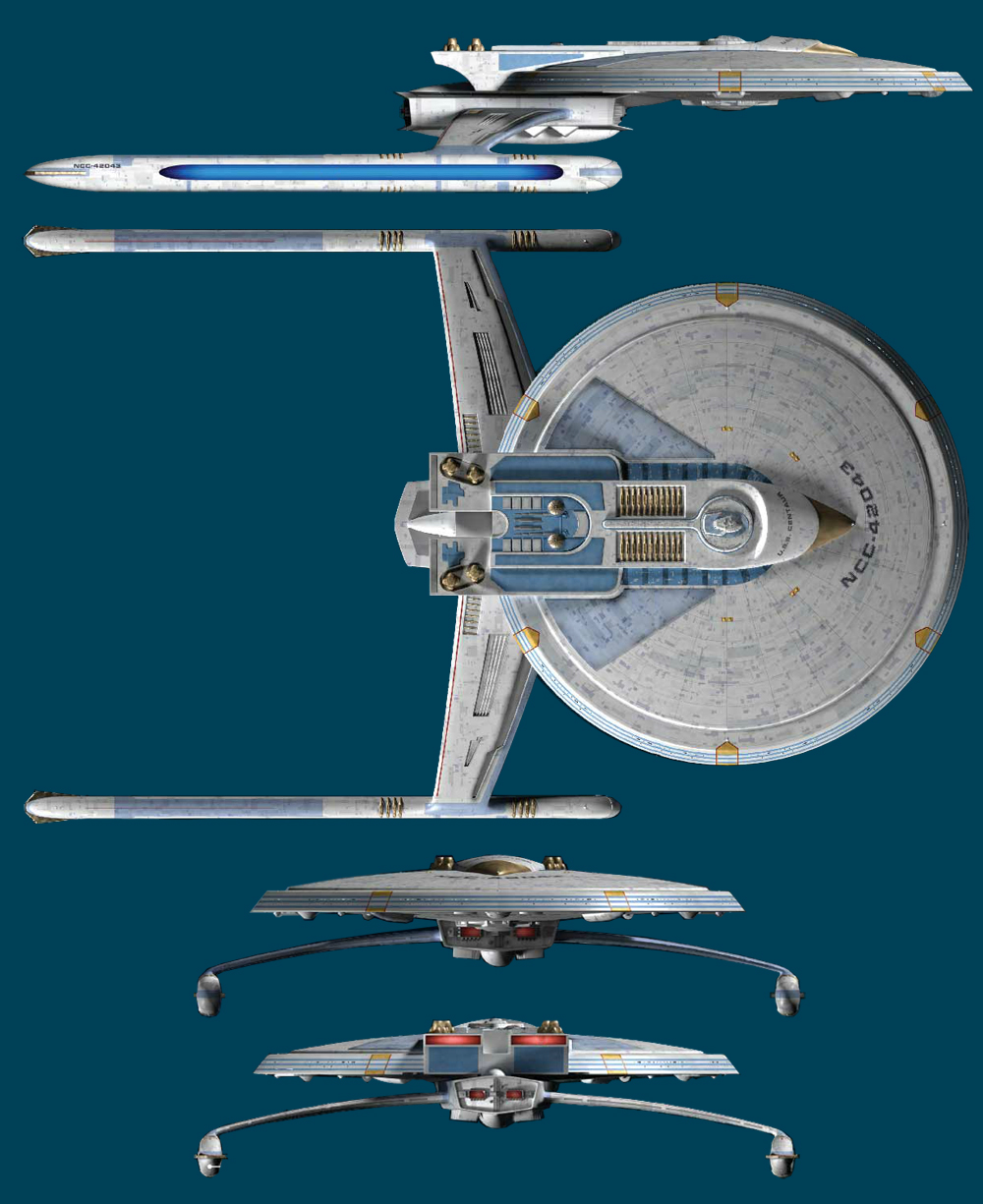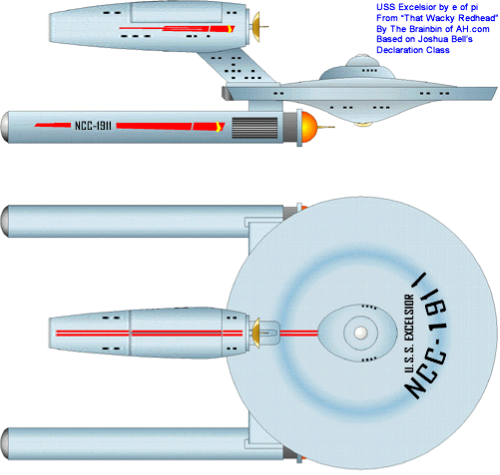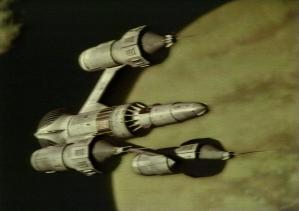What an incredibly detailed technical discussion! It's almost like I've actually stepped into my timeline

Tried to do some edits on that design to bring its engineering hull length more into line with the Enterprise's. I think it looks a lot less "stubby" with it stretched like this. (For the record, 1911 is Lucille Ball's birth year.)
For the record, e of pi and I did discuss this design as he was creating it and I give it my official stamp of approval - with the obvious caveat that the appearance of the outer hull would probably be modified slightly for the mini-series, as it was for the movies; however, it would remain closer to the style of the original series. I've already linked to
an OTL poster as my inspiration. That said, I like the "classic" look, and I imagine that it would catch on in the fandom ITTL, particularly among the Puritans.
Why? Remember that the
Excelsior was first mentioned in "These Were the Voyages", which marks the end of the universally accepted canon prior to the "schism". However, the ship was unseen in that episode, because it makes no sense to go through with a grand unveiling only for it to remain dramatically inert (remember, the crew goes on one last cruise in the
Enterprise at the end). But the above model
is a Matt Jefferies design; that's worth quite a bit, even from a Puritan perspective.
The registry number, however, would probably be a point of dispute. For obvious reasons, Puritans would prefer 1921 (the year that Roddenberry was born) or 1924 (the year that
Coon was born). Marvel Zombies would probably lobby for a number in between: 1922 (the year that
Stan Lee was born

). Unfortunately for them, Gold Key still has the comics licence... for now. However, there should be universal agreement on the registry number for the
Artemis: NCC-1966

May I also add something as well? Another thing which turned people off Laserdisc was that - even more so than the CED, which is understandable as it's a turntable for video - there were two types of discs. One of them had short running time but high quality, and the other was the total opposite. As such, not only did you have to constantly turn the disc over, but you also suffered a dip in picture quality depending on the type of disc the studio chose to distribute the movie or TV programme in. The quality issue was just as much of a concern as the price.
An excellent point - a key advantage of the victorious formats IOTL is that they were a good deal more
consistent.
Much as I keenly appreciate what Franz Josef did for OTL Trek fandom in those wandering-in-the-wilderness years of the 1970s, as much as I treasured my Technical Manual in those days--I never really liked the idea that bigger and smaller Starfleet ships would use more or fewer than 2 warp drive nacelles.
At the end of the day, I'll state the obvious: the
Enterprise, and all other ships, have two nacelles because Matt Jefferies was a bomber pilot in WWII and wanted them to evoke the wings of a plane (or, indeed, of a bird in flight). It's really that simple. Now obviously, that doesn't make for a very good in-universe explanation.
Shevek23 said:
The "Declaration" class on the other hand, just looks goofy to me. Of course we kind of want it to, so everyone is thrilled to see Kirk take charge of Enterprise again as you said!

This is absolutely true. Even with e of pi's improvements to the rendered design, it
still looks "off", which is exactly what we want from an in-universe perspective.
I doubt we'd see anything of a technical manual style released in the time of the original run, so there still might be that hole in the merchandise market if Franz Joseph still gets around to it. By the late 70s, though, there's something else on the horizon: the Brainbin has hinted of a coming Star Trek RPG on the horizon in around '77-'78, which would of course need gaming books. Books that would need some mechanical details for various ships, if only within the game system (is the Artemis faster than the Enterprise? How much damage can the Excelsior take before it loses shields? Is that more than the Enterprise? What are those classes called, anyway?). Books that would be potentially able to take advantage of behind-the-scenes access to the miniseries designers, props rooms, and maybe even sets. Books that would be officially licensed references for the rules and background of the Star Trek world--perhaps the first official compendiums thereof, distilling fandom debate over comics, the miniseries, the original show, and any fandom works like Franz Joseph into something that can work in the same semi-cohesive whole for gaming. That's going to give those books tremendous weight in the field of fandom, at least among the hardcore Treknologists.
It's very much looking like Appendix A, Part IX will be increasingly informed by this kind of material.
e of pi said:
Given Roddenberry actually managed to sell other shows than Star Trek ITTL, I doubt he's giving the question of Trek too much thought at all beyond cashing the checks.
This is really the
major paradigm shift with regards to 1970s fandom. IOTL, Roddenberry was very much venerated as a prophetic figure, with his "vision" for the future and for space exploration serving as a rallying philosophy for the Trekkies/Trekkers/Trekkists. Better men than him have let themselves become seduced and corrupted by the allure of such devotion, and sure enough, he was as well. But ITTL, the only Trekkies who will revere him in the same way are the Puritans, who are generally considered odious and pedantic by the rest of the fandom (and even
then, Roddenberry will merely be part of a greater pantheon, alongside primarily Coon, among others).
Also, don't forget the comics: the longer that goes, the more likely artists & writers will conceive other Fleet ships; some tech details will be (at a minimum) helpful, if not outright necessary.
For reference,
Star Trek went for 137 episodes without showing any Federation starship other than those in the same class as the
Enterprise; by February of 1978, we're
still looking at fewer issues than that of the main
Star Trek comic.
After the mini-series, of course (and perhaps even in the run-up thereto), all bets are off.
That'd be basically a whole new layout. You're talking something like the DS9 Centaur-class, but using TOS-style features rather than (OTL) Excelsior-style components?
It'd make a better frigate like the Artemis than a cruiser, I think--just doesn't come off as "solid" enough for a flagship. Definitely more birdlike, but I like the Miranda a bit better.
As do I, though you should all know that e of pi is understating his enthusiasm for the
Centaur model. But the
Miranda-class
is more "authentic", so to speak.
There should all be a, well, um, syzygy, to it.
Very well said - and you highlight the ludicrous precision of the Puritan viewpoint ("Two Genes or Bust", to put it bluntly), when virtually
everyone else who worked on the original series has significant input on most of these products (and not just "hauled them out of mothballs for a last-minute endorsement" input, either - and speaking of which...)
Shevek23 said:
My head canon on all this largely influenced by Rick Sternbach's OTL TNG Technical Manual; "dipole field" and "peristalsis" are mantras. Also the word "antisymmetry..."
I'd have to search the thread to remind myself whether Brainbin already has inducted Sternbach into the Desilu Team Trek or not. If not, I don't think he was totally making that stuff up about warp geometries on his own, nor for that matter was Roddenberry, entirely. It possibly was at least a vague consensus among the original series team.
You really need to divorce yourself from technical manuals for shows that will never exist ITTL. Take a bottom-up approach to how the technology will be explained, basing your observations strictly on the established canon. And as for Sternbach - well, if I were to judge him solely by
the company he keeps...

My thoughts were always vaguely along the lines of each nacelle develops a globular field with a major axis dependent on the nacelle length. These fields are then distorted by various components in the ship - the main hull causes a distortion so that the "push" caused by interaction of the fields is therefore behind it.
An
intriguing hypothesis, Professor - though I'll be honest here. As an enthusiast of popular culture, I tend to care very little about the nature of warp drive. Obviously I've made educated guesses based on observation, just like anyone else; but technobabble has never been one of my passions (one of the
many reasons I prefer
Star Trek to the many spin-offs that followed IOTL, all of which were
lousing with the stuff). I'm definitely going to lean
very heavily on my consultants with regards to this matter.
Sternbach's not even in the business yet--he got into TV/Movie work after hearing about McQuarrie's work on Star Wars IOTL. We'll have to see how that turns out once Brainbin gets around to breaking all the suspense he's built up about what the beflanneled one has been up to--McQuarrie might not even work on Star Wars

eek

.
And we'll be hearing from He With the Flannel and the Beard sooner, rather than later!

Well, if McQuarrie still does the art for Asimov's Robot Stories anthologies, than it is fine


One science-fiction property at a time, now

When's the next update coming?
Ah yes, an excellent question. And the answer is: in a few days! Thank you, everyone, for your patience.


